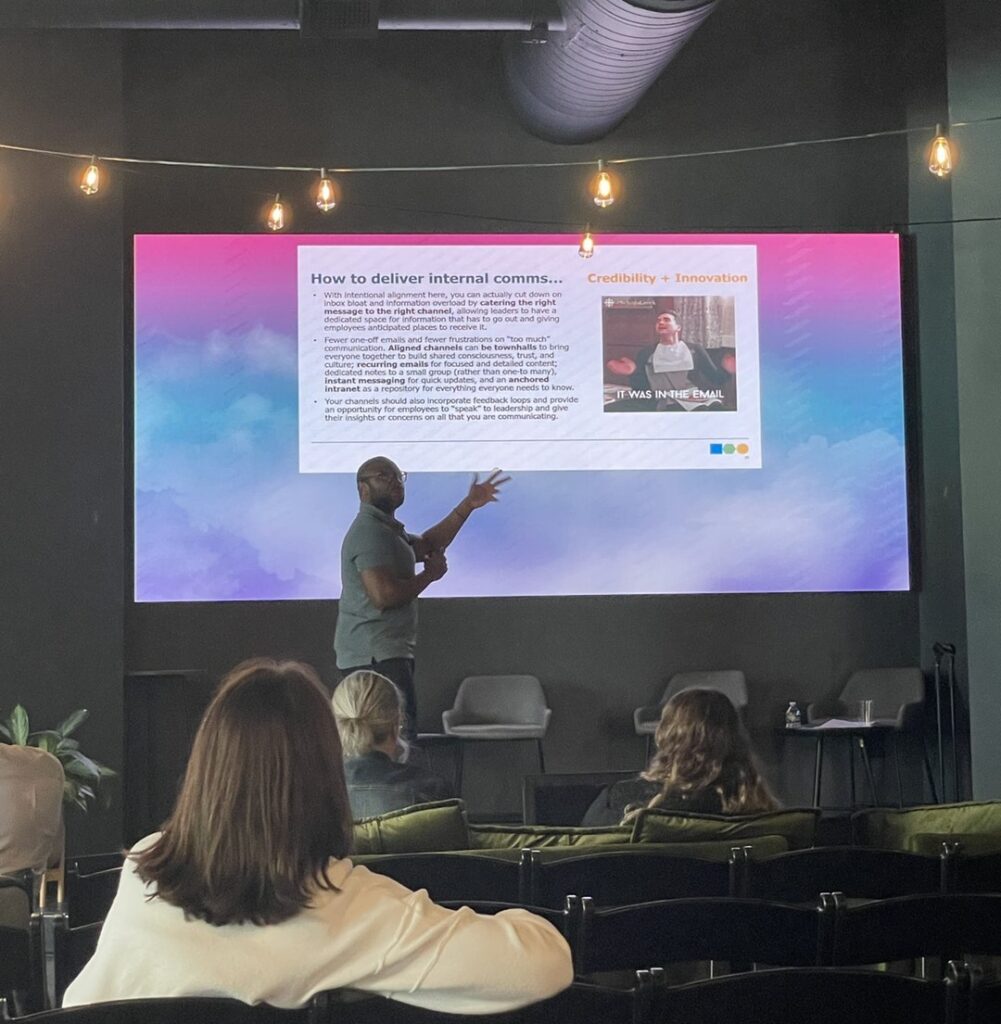MHM 2024, the biggest gathering for marketers in mental and behavioral health, was a wild ride — and I don’t just say that because we sponsored a whole dang hot air balloon so everyone could experience the natural high that comes from working with Cardinal. With so many knowledgeable, mission-driven, and downright friendly mental and behavioral health marketing experts, I definitely learned a few things that seemed worth passing along.
Table of Contents
- Marketing and Operations Alignment is a MUST
- AI Isn’t the Answer for Behavioral Health Marketing
- Speak the Language of Your Audience with Patient-Centric Communication
- Urgency is the Key to Behavioral Health Patient Experience
- Data in Mental Health Marketing Is More Than Patient Numbers
- Engage Clinical Staff to Improve Content and Patient Trust
- HIPAA Compliance and Marketing: Navigating the Challenges
- Healthy Behavior for Behavioral Health

I was there preaching the gospel of MOPS Alignment as usual, but my other biggest takeaways were that when it comes to mental and behavioral health, messaging should be human, care should be urgent, and deeper (HIPAA compliant) data dives can help expand and improve your practice. And I’ve got a few suggestions for things you can be doing to improve in all those areas. Still, my first message to everyone would always be this:
Marketing and Operations Alignment is a MUST
Not a “possible strategy.” Not an “approach to consider.” MOPS alignment is *crucial* for success, and strong internal communication is the only way to ensure that your marketing is all being done with an understanding of what the business needs. Clarifying those shared goals is what drives more effective patient acquisition strategies.
I had a great session with Anna Sciarillo from Empower Behavioral Health, where we discussed the finer points of MOPS alignment, such as how operational capacity needs to be a serious consideration for any marketing campaign. You have to understand your staffing levels, current waitlists, etc., to ensure you’re driving high-quality leads to the locations that can efficiently convert them.

And it’s not just me preaching the MOPS gospel. evolvedMD’s Sentari Minor gave a session on how a strong internal communication strategy from senior leadership keeps everyone on the same page in terms of goals, mission, and company culture. Alignment is essential.

Action Checklist:
- Ensure senior leadership clearly communicates company goals and updates
- Facilitate regular check-ins between marketing and operations teams
- Create a capacity-driven client acquisition strategy
AI Isn’t the Answer for Behavioral Health Marketing
While I think AI is better for data crunching than for client-facing marketing in general, there are a few places where it’s less appropriate than mental health marketing. Mental and behavioral health is all based around human connection and understanding, which means the last thing you should be doing is throwing up AI-generated slop from ChatGPT at potential clients who are seeking providers with human empathy.
We heard this time and again in multiple sessions from behavioral health experts, who explained that mental health relies on authentic, human-driven communication. Sure, ChatGPT might generate content quickly, but it doesn’t have the emotional nuance required to connect with patients facing complex mental health issues.
EnticEdge CEO Julie Weber Ugarte stressed that using AI risks diminishing the quality of patient care by depersonalizing the message. AI-generated content may be cheap, but part of being “cost-effective” is being effective. Behavioral health relies on compassionate and authentic messaging that aligns with the organization’s mission to serve patients and ensure that patients feel heard and understood. AI-generated content undercuts that, and if anything, practices should be putting even more care into behavioral health messaging by regularly updating website copy and maintaining messaging consistency.
Action Checklist:
- Avoid using AI tools to draft website copy, ads, or branding materials
- Seriously, don’t use AI-generated content that risks damaging your brand
- Craft messaging that addresses patients’ emotions and concerns on a human level
(and a great way to do that is…)
Speak the Language of Your Audience with Patient-Centric Communication
One of the first things you learn doing search marketing is that you want to be using the language your patients use, rather than medical terms. Nobody says, “I have a viral infection of the upper respiratory tract.” People say, “I have a cold”, they search for ways to deal with having a cold, and they want to hear helpful information about colds rather than viral respiratory infections.
Behavioral health is the same way. Patients don’t often search for terms like “anorexia” or “bulimia”; they look for broader, more relatable terms like “eating disorder.” Dropping the medical jargon in favor of more familiar terms isn’t just a good search marketing strategy, it’s also an effective messaging strategy that shows empathy with your potential patients by using language that resonates and makes them feel understood.
Nowhere is that more relevant than in mental and behavioral health, which is why you should always adjust your language to your audience. Technical terms are useful for clinical use, but messaging patients and their families — especially in person — should always use terms they are familiar with. Meeting patients where they are is doubly important given that patients are frequently already anxious when they arrive at your website; the last thing you want to do is overwhelm them further with medical jargon.
Action Checklist:
- Audit all patient-facing content for medical jargon
- Replace clinical terms with more accessible and familiar language
- Instead of “bipolar disorder”, try “mood swings” or “extreme highs and lows”
Urgency is the Key to Behavioral Health Patient Experience
When it comes to mental health and addiction care, patients need help NOW. Someone reaching out for mental health or addiction care needs immediate support — whether for themselves or a loved one — and if you can’t provide that support in a timely fashion, the patient will seek out a provider who can. For this reason, it’s essential to have someone available to answer calls or follow up in real-time, to let patients know that you are ready to help.
This was a big theme of the conference, and speakers suggested various ways to improve immediate support offerings, from call center optimization, to same-day appointments, to real-time telehealth options. Data shows that many mental health and addiction patients seek help outside of regular business hours, often late at night, which means that behavioral health providers need to have systems in place to respond to patients in the moment even when that moment is far outside of the usual 9-5 workday. Live chat, 24/7 call centers, and on-demand telehealth consultations are all workable options, but you need something in place.
Lightfully Behavioral Health CGO Andie Hollowell put it like this:
“When someone is struggling, it does not help them if they call in and no one calls them back for 3 days. That is not helpful. If anything, that is more distressing for the family and the client. How can we do things with compassion, but how can we do things as urgently as possible?”
(Bonus tip: This is a reason that “CALL NOW” is one of the best CTAs for a website.)

Action Checklist:
- Implement a 24/7 support system to ensure help is available when patients need it most
- If live staff isn’t an option, make use of technology-assisted services like telehealth
- Review call tracking data to determine peak patient outreach hours and staff accordingly
Data in Mental Health Marketing Is More Than Patient Numbers
Everyone knows that data should inform your marketing strategies, but you’re not going to get much nuance if the only data points you’re tracking are new patient numbers.
Metrics like new leads and patient acquisition are important, but there’s a lot of valuable insight about the patient journey to be mined from other data points like conversion rates and post-treatment outcomes. Especially important is tracking metrics like follow-up times and appointment scheduling speed, because they are central to the patient experience.
Coastal’s Melissa Taliaferro summed it up by saying, “We as consumers want frictionless interaction,” so that’s the goal in terms of patient-centric care.
By making good use of data, you can identify and target high-need geographies, as well as optimize lead quality. Even qualitative data like patient experiences and feedback shouldn’t be overlooked just because they’re trickier to quantify; they’re still valuable in terms of shaping more effective and patient-centered marketing efforts.
The goal is to improve the patient experience and operational efficiency, and tracking the right data can help do both.
Action Checklist:
- Collect a broader range of data points, such as follow-up times and success rates
- Include qualitative data like patient satisfaction surveys
- Use predictive analytics to anticipate needs and tailor patient outreach
Engage Clinical Staff to Improve Content and Patient Trust
Clinical staff are a valuable resource that offer two great benefits for your marketing:
- Deep subject matter knowledge to make complex medical concepts understandable
- Frontline experience to address patient concerns in a relatable way
Involving clinical staff in your content marketing lets you leverage both of these skills to provide relevant and trustworthy content that will help you build credibility with your patients. Be sure that you’re approaching clinicians to respectfully ask for the benefit of their expertise in helping to educate potential patients; don’t just say, “Hey, help me with marketing.” Consider having marketing teams observe clinical meetings to better understand patient needs.
Action Checklist:
- Establish a structured collaboration between your marketing and clinical teams.
- Marketers should interview clinicians regularly to gather insights
- Ensure that clinical staff feels valued for patient education, not just marketing efforts
HIPAA Compliance and Marketing: Navigating the Challenges
Last but not least, HIPAA compliance remains a concern for mental health marketers as it does for all healthcare marketers. I jumped on a panel to say that we shouldn’t see HIPAA regulations as a problem, but a prob-portunity. By updating your marketing with HIPAA-compliant tools, you can actually improve your data collection while also bolstering patient trust.
You do need to actually update your marketing tech stack to be HIPAA-compliant though; just updating your privacy policy isn’t good enough.

Action Checklist:
- Conduct an internal audit of your data practices to ensure compliance
- Invest in HIPAA-compliant analytics solutions like Customer Data Platforms (CDPs)
- Be transparent with your patients about how their data is being used
Healthy Behavior for Behavioral Health
And that’s what I learned at summer camp —sorry, I mean MHM 2024. (Guess that hot air balloon was just too fun.) Patients want to connect with a human element in messaging, and they want to receive an immediate response when they reach out for care. On the internal side, marketing should be making good use of the valuable assets you already have, by collaborating with clinical teams to improve messaging and using data strategically to fine-tune marketing efforts.
I hope these insights are valuable for you and that by following the action steps I’ve laid out, you might improve not just your behavioral health marketing strategies but the experience of your patients as well. Of course, if you’d like more personalized advice on what your behavioral health group specifically should be doing to improve your marketing, feel free to reach out, and we’ll set up a time to chat.


